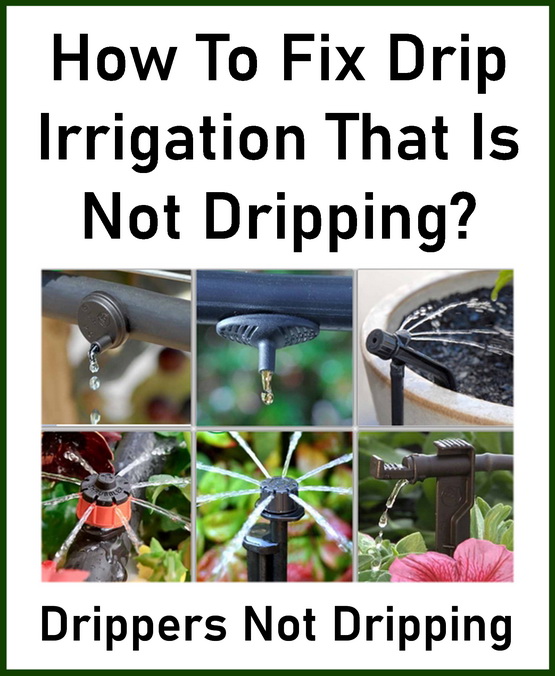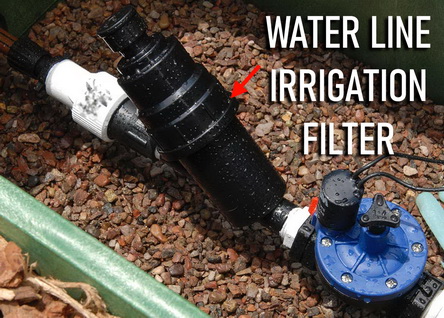Issues with your irrigation water lines not dripping water as needed? Here are solutions to ensure your drip system operates efficiently. Drippers, water lines, and tubing can be repaired or replaced no matter if it is on flat ground or level ground.
 How to fix irrigation drippers not dripping?
How to fix irrigation drippers not dripping?
Understanding Drip Irrigation Systems
Components of a Drip System
A drip irrigation system typically consists of the following components…
- Water source: This is where the system connects to the main water supply.
- Pressure regulator: This device ensures that the water pressure is at the optimal level for the drippers.
- Filter: The filter prevents debris and sediment from entering the system and clogging the drippers.
- Tubing: The main water lines that transport water throughout the system.
- Drippers: Small devices that release water directly onto the soil or plant roots at a controlled rate.
 Drip irrigation water filter location
Drip irrigation water filter location
Causes of Non Dripping Water Lines
If you find that your irrigation water lines on your drip system are not dripping water, the following issues may be the culprit…
Clogged Drippers
The most common reason for water lines not dripping is clogged drippers. Debris, sediment, and mineral deposits can build up over time, obstructing the water flow. To resolve this issue…
- Remove the clogged dripper and clean it thoroughly with a small brush or toothpick.
- Flush the tubing to remove any remaining debris.
- Reinstall the cleaned dripper and test the system.
Remove and replace a drip emitter dripper
Insufficient Water Pressure
If your water lines are not dripping, it could be due to low water pressure. The pressure regulator may be set too low, or there might be a leak in the system. To address this issue…
- Check the pressure regulator setting and adjust if necessary.
- Inspect the water lines, tubing, and connections for leaks and repair as needed.
Damaged or Kinked Tubing
Damaged or kinked tubing can restrict water flow in your drip system. Examine your tubing for any visible damage, kinks, or pinched sections. Replace or repair the damaged sections to restore proper water flow.
Incorrect Installation
If your drip system is not installed correctly, the water lines may not drip as intended. This can occur if the system is placed on uneven or sloping ground, causing an inconsistent water flow. To correct this issue, ensure that your drip system is installed on flat or level ground.
Tips for Proper Installation
- Use stakes or landscape staples to secure your tubing in place.
- Install your system on level ground or terrace sloping areas to maintain consistent water flow.
- Regularly inspect and maintain your system to prevent issues before they become problematic.
Benefits of Drip Irrigation
Drip irrigation offers numerous advantages over traditional watering methods, such as…
- Water conservation: By delivering water directly to plant roots, drip systems minimize evaporation and runoff.
- Targeted watering: Drip irrigation allows for precision watering, ensuring that each plant receives the right amount of water.
- Reduced weed growth: By limiting water to specific areas, drip systems discourage weed growth by depriving them of water.
- Improved plant health: Consistent and controlled water flow reduces stress on plants, promoting healthy growth.
Drippers FAQ
How often should I clean my drip irrigation system?
Regular maintenance is essential to keep your drip system functioning properly. Clean the filter and drippers every few months or when you notice a decrease in water flow. For hard water areas, consider using a water softener to reduce mineral buildup.
How do I know if my water pressure is too low?
If your drippers are not releasing water or are releasing it very slowly, your water pressure may be too low. Check the pressure regulator setting and adjust as needed. If the issue persists, consult a professional to assess your water supply and system.
Can I use a drip irrigation system for my entire garden?
Yes, drip irrigation systems can be customized to accommodate various garden sizes and plant types. With proper planning and installation, a drip system can efficiently water your entire garden.
How do I choose the right dripper for my plants?
Selecting the appropriate dripper depends on your plant’s water requirements, soil type, and climate. Consult a local expert or irrigation specialist for guidance on the best dripper for your specific needs.



Leave a Reply